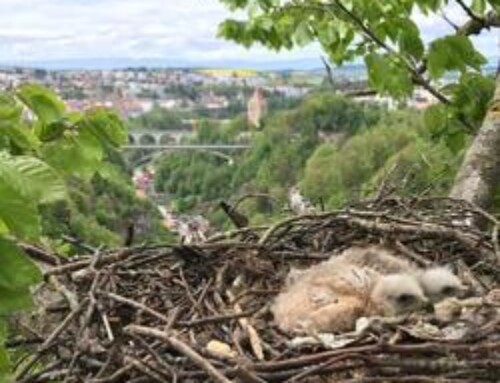LINKED PAPER
The migration system of Barn Swallows Hirundo rustica breeding in Southwestern Spain and wintering across West Africa. López-Calderón, C., Magallanes, S., Marzal, A. & Balbontín, J. 2021 Ardeola. DOI: 10.13157/arla.68.2.2021.ra2 VIEW
 The bulk of migratory birds that perform regular annual movements between breeding and wintering grounds constitute a strong ecological link among continents (Kays et al. 2015). Beyond this intrinsic scientific interest, it is required to know the whereabouts of migrants year-round before designing effective management decisions (Faaborg et al. 2010). Indeed, many migratory bird species are declining in population numbers, such as our study species the Barn Swallow Hirundo rustica.
The bulk of migratory birds that perform regular annual movements between breeding and wintering grounds constitute a strong ecological link among continents (Kays et al. 2015). Beyond this intrinsic scientific interest, it is required to know the whereabouts of migrants year-round before designing effective management decisions (Faaborg et al. 2010). Indeed, many migratory bird species are declining in population numbers, such as our study species the Barn Swallow Hirundo rustica.
Most migratory bird species are passerines; nevertheless, detailed information on bird migration is strongly biased towards raptors and waterbirds (Kays et al 2015). This gap in knowledge is led by body size, which traditionally has made the attachment of satellite transmitters on to small birds impossible. Thank to light level geolocators, this knowledge gap has been rapidly bridged in recent years (McKinnon et al. 2013). These are very small devices which record light levels at fixed time intervals and once the tagged individuals have been recaptured, latitude and longitude can be estimated following astronomical equations and statistical methods.
In this study, we used light-level geolocators to unravel the migratory performance of Barn Swallows breeding in the southwestern Iberian Peninsula. First, we reconstructed the migratory tracks of our study individuals, we then determined their migration schedules, and finally we identified the stopover and wintering areas used by our study population.
We monitored five breeding colonies of Barn Swallows in the provinces of Badajoz and Seville. From May to June 2016, 2017 and 2018, we captured adult Barn Swallows with mist nets and deployed, respectively, 64, 59 and 55 geolocator devices using leg-loop harness. In 2017, 2018 and 2019, we recaptured, respectively, 21, 8 and 16 tagged birds. Five of these tags did not provide any useful data and two individuals had lost the geolocator upon recapture. Thus, we were able to reconstruct 38 full migratory routes from the light data. For this purpose, we used the state-of-the-art R package FLightR (Rakhimberdiev et al 2017).
Each individual migratory track from this study can be visualized within an interactive map available here. “Downloadable 2” explains the functionality of the map and “Downloadable 3” is the interactive map. Figure 1 shows a subsample of three individual migratory tracks.
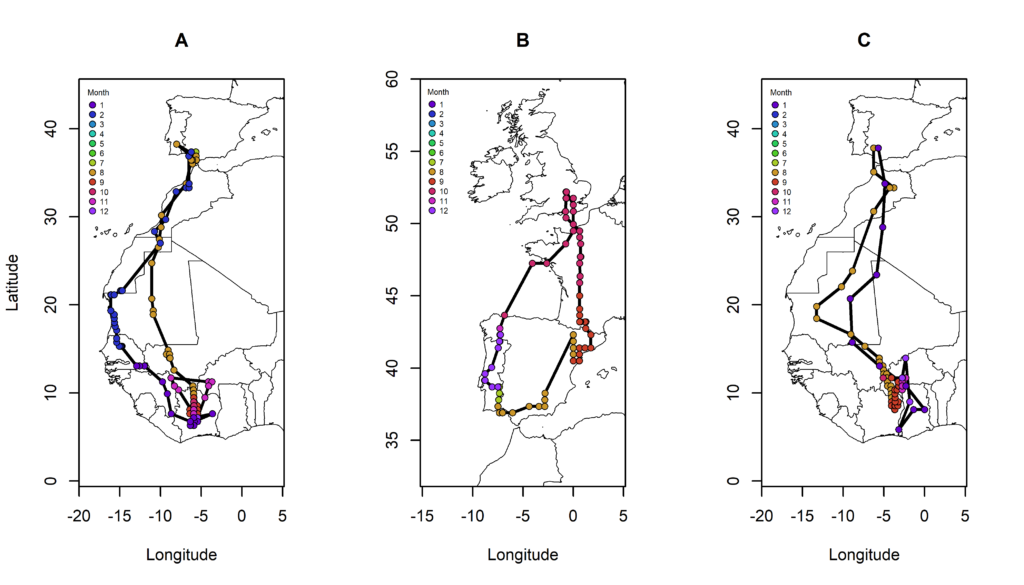 Figure 1 Migratory tracks of three different Barn Swallows tagged in 2016, 2017 and 2018, respectively. Subfigures A, B and C, represent ringed birds 2L12365, 2L12590 and 1Y83581, respectively. Dots indicate median position estimates given by the Markov chain simulation run with FLightR (Rakhimberdiev et al., 2017). Dot colours indicate the month of the year (see legend).
Figure 1 Migratory tracks of three different Barn Swallows tagged in 2016, 2017 and 2018, respectively. Subfigures A, B and C, represent ringed birds 2L12365, 2L12590 and 1Y83581, respectively. Dots indicate median position estimates given by the Markov chain simulation run with FLightR (Rakhimberdiev et al., 2017). Dot colours indicate the month of the year (see legend).
Our study Barn Swallows spent on average 22 days (Figure 2) wandering through southern Spain and northern Morocco (Figure 3A), a period that we defined as “pre-migration”. Then, they started to travel steadily southwards on average on the August 18th, stopping over to refuel in northern Morocco and southern Mali (Figure 3B), taking 16 days to reach the wintering grounds. Wintering areas were found mainly in Ivory Coast and surrounding countries (Figure 4), in localities dominated by savannahs, grasslands and crops. The wintering period took on average 145 days, from September 3rd to January 26th, when the tagged birds started to move steadily northwards. During spring migration, the majority of individuals stopped over to refuel across Senegal and Mauritania (Figure 3C), taking 23 days to reach their breeding colonies, on February 18th on average.
An exceptional individual migrated northwards in autumn, taking almost two months to reach England (Figure 1B). It remained there for two weeks and then it travelled back to Spain, taking 8 days to arrive to Galicia. Here this swallow overwintered from October 29th to December 18th, and finally it got to Badajoz on Christmas Eve.
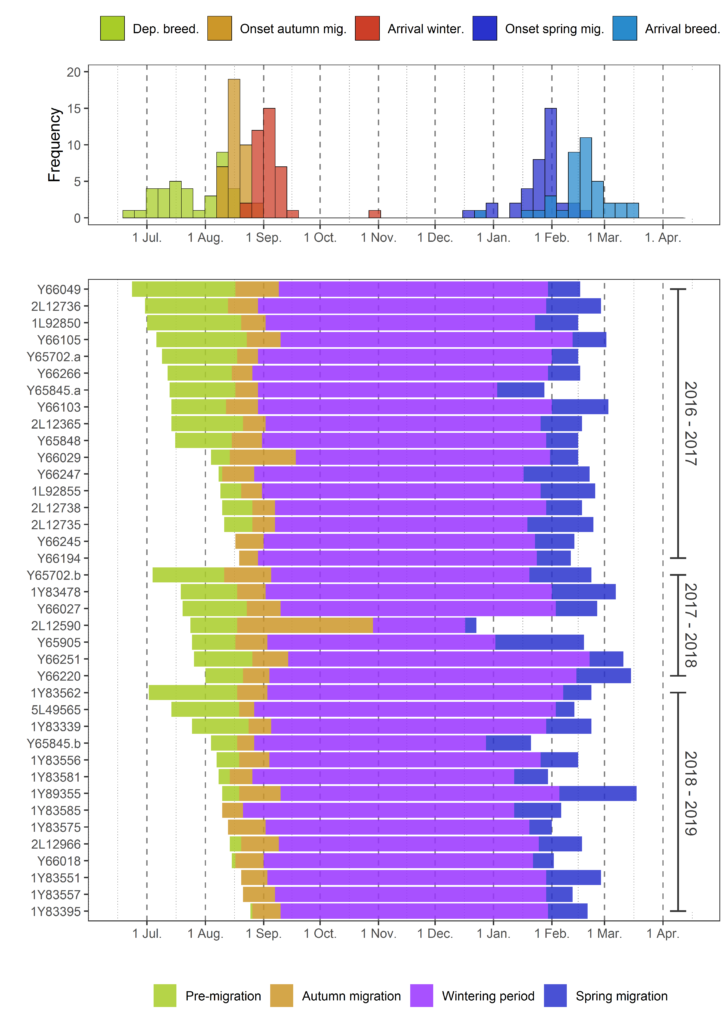 Figure 2 Distribution of migration schedules for our study population (histogram with key dates), and timelines with individual migration schedules of 38 Barn Swallows (horizontal bar plot with different stages along the life cycle). Individual 2L12590 conducted reverse migration northwards, the shortest track recorded.
Figure 2 Distribution of migration schedules for our study population (histogram with key dates), and timelines with individual migration schedules of 38 Barn Swallows (horizontal bar plot with different stages along the life cycle). Individual 2L12590 conducted reverse migration northwards, the shortest track recorded.
Compared to the previous Barn Swallow populations tagged across Europe (Liechti et al., 2014; Arizaga et al., 2015; Klvaňa et al., 2018; Briedis et al., 2018), our results show an advance of one to two months across all migration timetables. Thus, our study Barn Swallows adjusted their life cycle to the specific growing season of southern Spain (delimited from mild winters to scorching and dry summers).
The identified stopover areas in Morocco and Senegal represent the last patches of suitable habitats that Barn Swallows used to increase fat loads before crossing the Sahara desert in the autumn and spring migration respectively. On the other hand, the stopover areas identified in Mauritania during the spring migration may represent certain oases used to refuel and to recover from fatigue while crossing the desert.
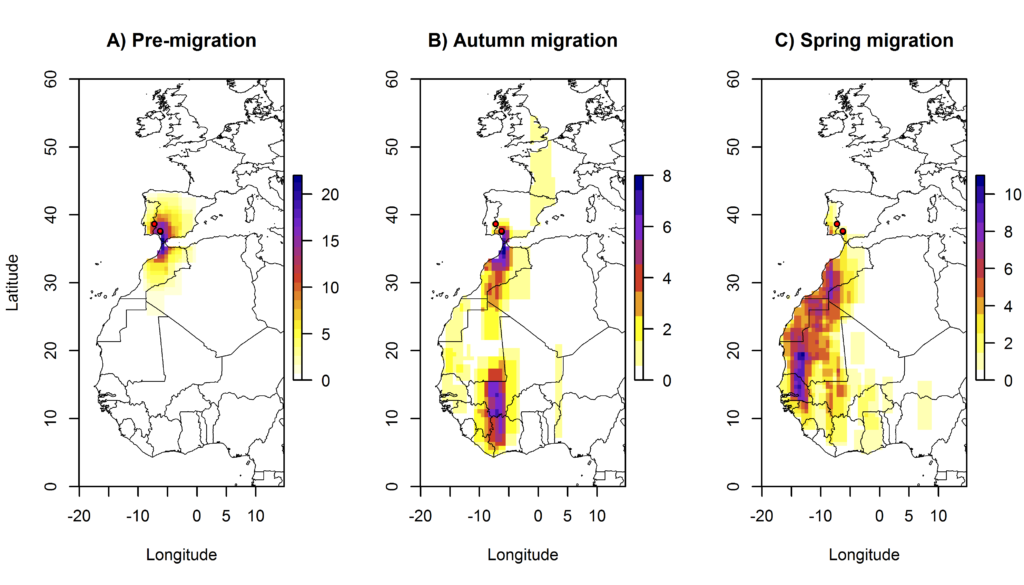 Figure 3 Stopover areas used by our study population during pre-migration (A), autumn migration (B) and spring migration (C). Colours indicate the number of birds that were located at the specific pixel. Stopover areas for each individual were defined as error squares of stopover locations. Breeding colonies are denoted by red dots.
Figure 3 Stopover areas used by our study population during pre-migration (A), autumn migration (B) and spring migration (C). Colours indicate the number of birds that were located at the specific pixel. Stopover areas for each individual were defined as error squares of stopover locations. Breeding colonies are denoted by red dots.
The wintering areas we identified across West Africa are similar to wintering areas identified for many other trans-Saharan migrant species (Walther & Pirsig, 2017). Clearly, the importance of these wintering sites requires consideration when proposing measures for the conservation of Palearctic migrants.
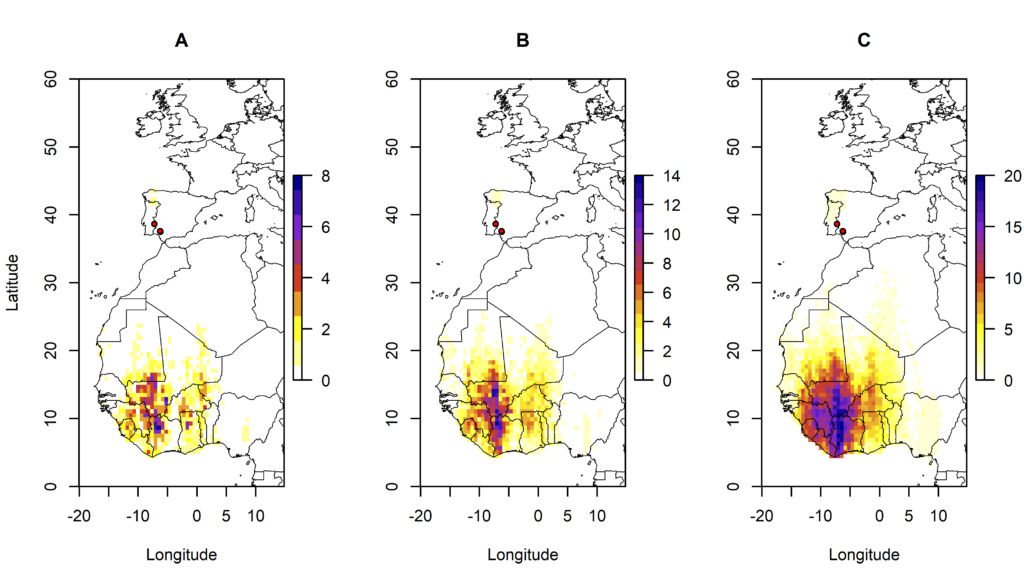 Figure 4 Wintering areas used by our study population. Subfigures show different spatial scales used to define individual winter areas: grid points that accumulated more than 50% (A), 75% (B) and 95% (C) of probability of occurrence during winter. Colours indicate the number of birds that were located at the specific pixel. Breeding colonies are denoted by red dots.
Figure 4 Wintering areas used by our study population. Subfigures show different spatial scales used to define individual winter areas: grid points that accumulated more than 50% (A), 75% (B) and 95% (C) of probability of occurrence during winter. Colours indicate the number of birds that were located at the specific pixel. Breeding colonies are denoted by red dots.
Finally, the large variance we found here for departure date from wintering areas and arrival date to breeding areas may help to explain carry-over effects from the winter to the breeding stage. Since some swallows arrive at their breeding colonies much earlier than others do, they should experience benefits in subsequent reproduction.
References
Arizaga, J., Willemoes, M., Unamuno, E., Unamuno, J.M. & Thorup, K. 2015. Following year-round movements in Barn Swallows using geolocators: could breeding pairs remain together during the winter? Bird Study 62: 141-145. VIEW
Briedis, M., Kurlavičius, P., Mackevičienė, R., Vaišvilienė, R. & Hahn, S. 2018. Loop migration, induced by seasonally different flyway use, in Northern European Barn Swallows. Journal of Ornithology 159: 885-891. VIEW
Faaborg, J., Holmes, R.T., Anders, A.D., Bildstein, K.L., Dugger, K.M., Gauthreaux Jr., S.A., Heglund, P., Hobson, K.A., Jahn, A.E., Johnson, D.H., Latta, S.C., Levey, D.J., Marra, P.P, Merkord, C.L., Nol, E., Rothstein, S.I., Sherry, T.W., Sillett, T.S., Thompson III, F.R. & Warnock, N. 2010. Conserving migratory land birds in the new world: Do we know enough? Ecological Applications 20: 398-418. VIEW
Kays, R., Crofoot, M.C., Jetz, W. & Wikelski, M. 2015. Terrestrial animal tracking as an eye on life and planet. Science 348: aaa2478. VIEW
Klvaňa, P., Cepák, J., Munclinger, P., Michálková, R., Tomášek, O. & Albrecht, T. 2018. Around the Mediterranean: An extreme example of loop migration in a long‐distance migratory passerine. Journal of Avian Biology 49: 01595. VIEW
Liechti, F., Scandolara, C., Rubolini, D., Ambrosini, R., Korner-Nievergelt, F., Hahn, S., Lardelli, R., Romano, M., Caprioli, M., Romano, A., Sicurella, B. & Saino, N. 2014. Timing of migration and residence areas during the non-breeding period of barn swallows Hirundo rustica in relation to sex and population. Journal of Avian Biology 46: 254–265. VIEW
McKinnon, E.A., Fraser, K.C. & Stutchbury, B.J.M. 2013. New discoveries in landbird migration using geolocators, and a flight plan for the future. The Auk 130: 211-222. VIEW
Rakhimberdiev, E., Saveliev, A., Piersma, T. & Karagicheva, J. 2017. FLightR: an R package for reconstructing animal paths from solar geolocation loggers. Methods in Ecology and Evolution 8: 1482-1487. VIEW
Walther, B. & Pirsig, L. 2017. Determining conservation priority areas for Palearctic passerine migrant birds in sub-Saharan Africa. Avian Conservation and Ecology 12: 1. VIEW
Image credit
Top right: Barn Swallow Hirundo rustica © Alejandro Pérez Diosdado




